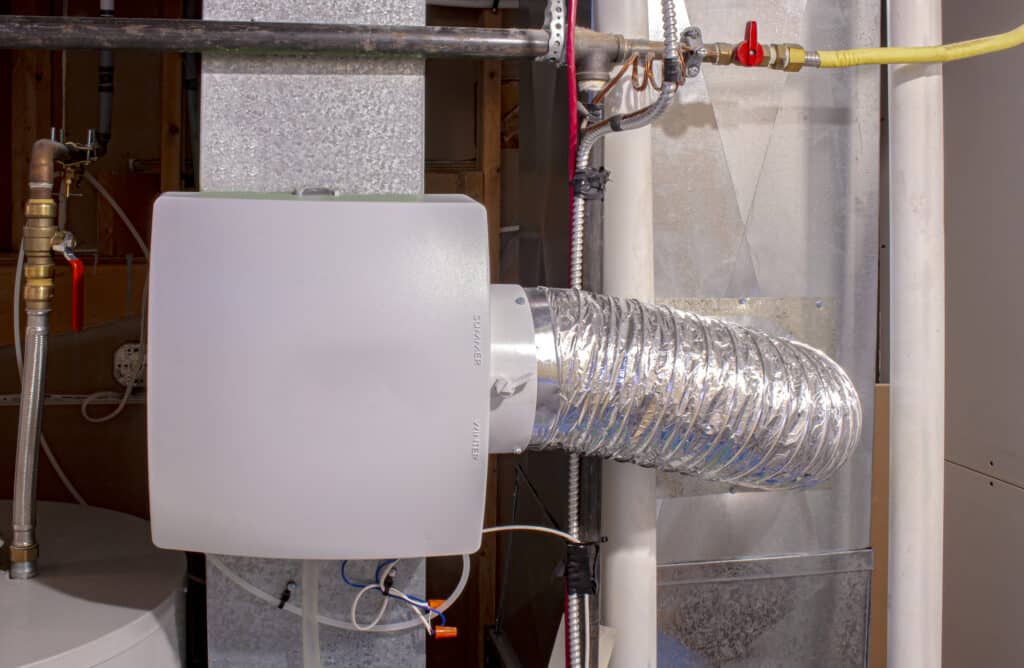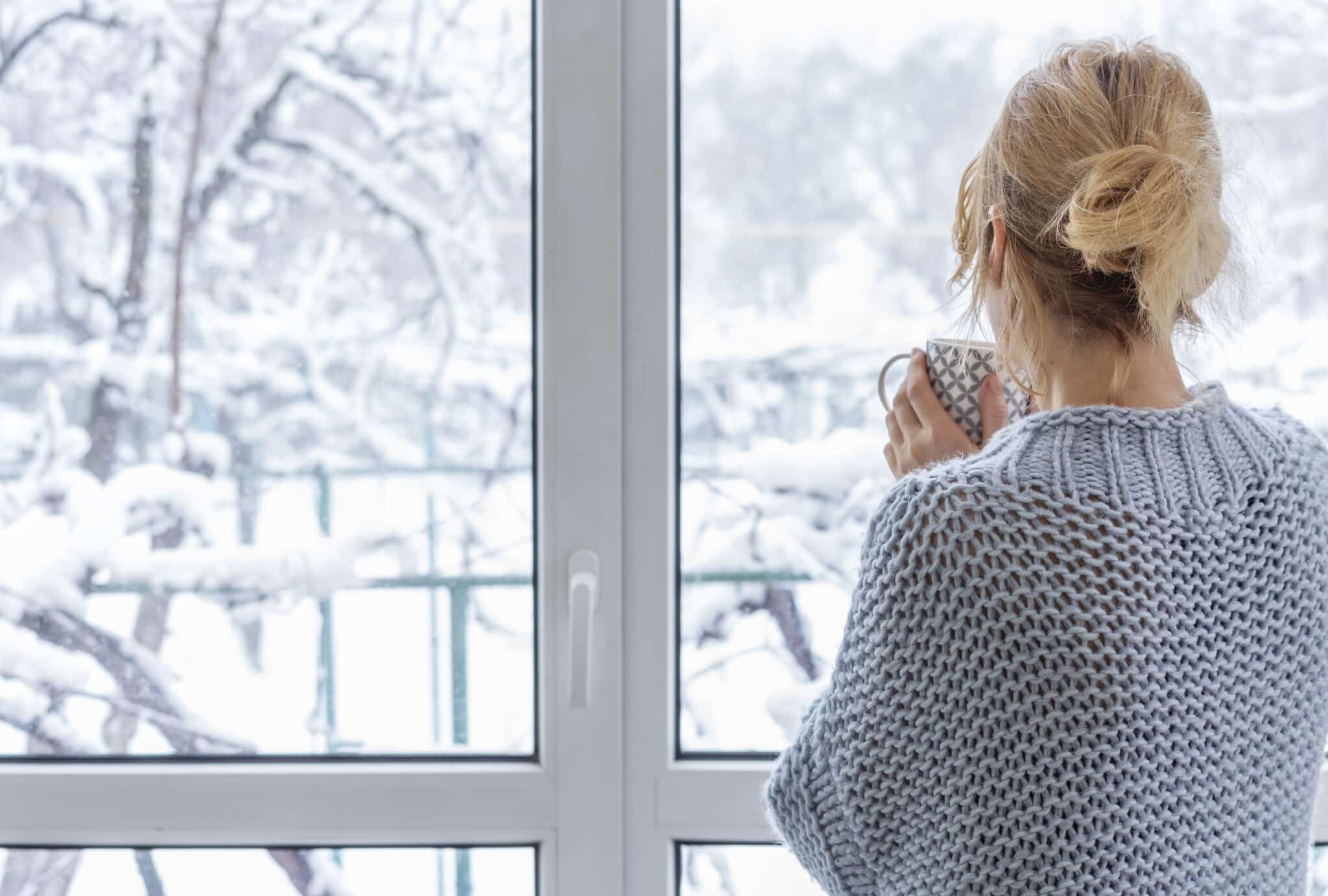Winter’s dry air doesn’t just affect your comfort—it can take a toll on your health and your home. A whole-home humidifier could be the perfect solution. In places like Cockeysville, MD, Timonium, MD, and Pikesville, MD, winter heating dries out indoor air, causing chapped skin, scratchy throats, and even damage to your furniture.
A whole-home humidifier adds just the right amount of moisture to your air, keeping humidity levels ideal for your comfort and health. It works with your HVAC system, helping you avoid the hassle of portable humidifiers while protecting your home from dry air damage.
What Is a Whole-Home Humidifier?
A humidifier integrated with your HVAC system adds moisture to the air throughout your entire home. Unlike portable units that only work in a single room, these systems ensure consistent humidity levels in every space. They use your home’s airflow to evenly distribute moisture, creating a balanced and comfortable environment.
Connected directly to your HVAC, they require minimal maintenance and operate automatically, eliminating the need for constant adjustments. This setup is perfect for tackling the dryness caused by winter heating, keeping your home healthier and more comfortable.

Common Problems Caused by Dry Winter Air
Health Issues
Dry winter air can lead to a range of health problems, from chapped lips and cracked skin to irritated eyes and scratchy throats. Low humidity also dries out your nasal passages, making it easier for viruses and bacteria to cause colds or respiratory infections.
You might notice more coughing, congestion, or even nosebleeds during the winter months. People with allergies or asthma may find their symptoms worsening due to the dry air’s effect on their respiratory system. A lack of moisture in the air isn’t just uncomfortable—it can have serious consequences for your overall health.
Damage to Furniture and Floors
Dry air pulls moisture from the wood, which can cause your floors, furniture, and even musical instruments to crack, warp, or shrink. If you’ve noticed gaps between your floorboards or splits in wooden furniture during winter, low humidity is likely the culprit.
Even painted surfaces can suffer as the dryness causes peeling or cracking. Over time, this damage can become costly to repair or replace. Maintaining proper indoor humidity with a whole-home humidifier can protect these valuable parts of your home.
Static Electricity
Static shocks become more common in winter because dry air reduces the moisture that normally helps dissipate electrical charges. You might find yourself zapped when touching doorknobs, light switches, or even other people.
This can be more than just annoying—it can also interfere with electronics, causing minor malfunctions or damage. Adding humidity to the air reduces the conditions that allow static electricity to build up. A properly humidified home keeps these frustrating shocks at bay.
Higher Energy Costs
When the air is dry, it feels colder, even if your thermostat says it’s warm. This often leads people to crank up the heat, which results in higher energy bills. A humidified environment helps retain warmth, meaning you can feel comfortable at a lower temperature setting.
By using a whole-home humidifier, you’ll not only improve comfort but also save money on heating costs. It’s an investment that pays off in both comfort and energy savings.
Benefits of Installing a Whole-Home Humidifier
1. Improved Comfort
A whole-home humidifier keeps your indoor air at an ideal humidity level, usually between 30% and 50%. This balance eliminates the discomfort caused by dry air, such as dry skin, irritated eyes, and scratchy throats.
You’ll notice fewer issues like static shocks and less dryness in the air, making your home more pleasant to live in. The added moisture helps your body feel warmer, reducing the need to layer up or crank the heat. Comfort improves for everyone in the household, making winter much more enjoyable.
2. Better Health
A balanced humidity level helps protect your nasal passages and respiratory system, reducing your chances of getting sick. Properly humidified air minimizes the spread of airborne viruses, keeping colds and the flu at bay.
It also soothes allergy and asthma symptoms by reducing dust and irritants in the air. Your skin stays hydrated, and issues like cracked lips and brittle hair become a thing of the past. Overall, your body feels healthier and less stressed in a home with optimal humidity.
3. Preserves Your Home
Humidity plays a big role in protecting the materials in your home, especially wood. A whole-home humidifier prevents cracks in hardwood floors, furniture, and even drywall caused by dry winter air. It also helps preserve delicate items like musical instruments, artwork, and cabinetry.
When your home maintains balanced humidity, you’ll avoid costly repairs and keep your space looking great. It’s an effective way to ensure the longevity of your home’s most valuable features.
4. Energy Savings
Humidified air feels warmer, so you can lower your thermostat without sacrificing comfort. With less need to crank up the heat, you’ll see a noticeable drop in your energy bills.
Over time, these savings add up, making the humidifier a cost-effective investment. Plus, by reducing your home’s energy use, you’re also doing your part to lower your environmental impact. It’s a win-win for your wallet and the planet.
5. Convenient and Low Maintenance
A whole-home humidifier is much easier to use than a portable one. It runs automatically with your HVAC system, so you don’t need to worry about refilling water tanks or adjusting settings.
Most models only require occasional filter changes and professional servicing once a year. Compared to the hassle of maintaining multiple portable humidifiers, it’s a no-brainer. With minimal effort, you’ll enjoy all the benefits of properly humidified air throughout your home.
How a Whole-Home Humidifier Enhances Air Quality
Balances Humidity Levels
A whole-home humidifier ensures your home’s air doesn’t become too dry or overly humid. Maintaining balanced humidity keeps your indoor environment comfortable while avoiding issues like condensation on windows or mold growth.
Proper humidity also prevents dry air from irritating your throat, nose, and skin. This balance creates a healthier living space for everyone in the home. It’s the perfect solution for maintaining consistent air quality throughout the year, especially during dry winter months.
Reduces Allergens and Irritants
Moist air helps trap and reduce airborne particles like dust, pet dander, and other allergens. These particles tend to float freely in dry air, which can worsen allergy and asthma symptoms.
By keeping your air properly humidified, you’ll breathe easier and experience fewer respiratory irritations. This also reduces the amount of cleaning you need to do to keep allergens at bay. The result is a cleaner, healthier home for you and your family.
Protects Skin and Hair
Dry winter air is notorious for leaving your skin feeling itchy, flaky, and uncomfortable. It can also make your hair brittle and prone to breakage. A whole-home humidifier helps combat these problems by adding moisture to the air, keeping your skin hydrated and your hair soft and strong.
You’ll notice a big improvement in how your skin and hair feel during the winter. Proper humidity isn’t just about comfort—it’s about looking and feeling your best.
Choosing the Right Whole-Home Humidifier
Types of Whole-Home Humidifiers
There are several types of whole-home humidifiers, each designed to cater to specific needs and preferences:
- Bypass Humidifiers: These systems rely on your HVAC system’s airflow to circulate moisture throughout your home, making them efficient and cost-effective. They are an excellent choice for homes with existing ductwork but may not be as powerful for larger spaces.
- Fan-Powered Humidifiers: Equipped with a built-in fan, these humidifiers generate higher moisture output, ensuring consistent humidity levels even in larger homes. They are slightly more energy-intensive than bypass systems but deliver superior performance.
- Steam Humidifiers: These advanced systems boil water to produce steam, providing the highest level of humidity for precise control in any climate. They work well in homes that require significant moisture addition but may need more frequent maintenance due to mineral buildup.
- Drum Humidifiers: Featuring a rotating drum and a water reservoir, these units are budget-friendly and straightforward to operate. However, they require regular cleaning to prevent the growth of mold or bacteria in the reservoir.
- Flow-Through Humidifiers: These systems allow water to flow over a pad and into the air, ensuring consistent and clean moisture delivery. They are low-maintenance and prevent standing water, reducing the risk of mold growth.
- Hybrid Humidifiers: Combining technologies like steam and evaporative methods, these units offer precise humidity control and enhanced efficiency. They are ideal for those who want the best features of multiple systems in a single, advanced unit.
Each type offers distinct benefits, so selecting the right one depends on factors like your home’s size, HVAC system compatibility, and desired maintenance level.
Factors to Consider
When selecting a humidifier, it’s important to evaluate a few key factors. Your home’s size plays a big role, as larger homes may need a more powerful unit. HVAC compatibility is another important consideration, ensuring the humidifier integrates seamlessly with your existing system. Maintenance requirements should also factor into your decision; some models need frequent filter changes, while others are low-maintenance.
Budget is always a consideration, but investing in the right unit can save money in the long run through energy efficiency and home protection. With these factors in mind, you’ll find the perfect solution for your home.
Professional Installation
To get the most out of your whole-home humidifier, professional installation is essential. Experts ensure the unit is correctly installed and integrated with your HVAC system for optimal performance. Proper installation also prevents issues like leaks or inefficiencies that can arise from DIY setups.
Professionals can recommend the best model for your home and make sure it operates safely and effectively. With professional help, you’ll enjoy the hassle-free, long-lasting performance of your new humidifier.
Maintenance Tips for Whole-Home Humidifiers
Replace Filters Regularly
Filters in your whole-home humidifier collect minerals and debris from the water, which can build up over time. Replacing these filters as recommended by the manufacturer is essential to maintain efficiency and prevent clogs.
Dirty filters can reduce the humidifier’s performance and may even lead to poor air quality. Regular replacement ensures the system runs smoothly and delivers clean, properly humidified air. It’s a simple step that makes a big difference in keeping your humidifier effective.
Clean Water Panels
Water panels, or pads, are critical components in humidifiers that distribute moisture into the air. Over time, these panels can accumulate mineral deposits, leading to reduced performance and even mold growth if not cleaned. Inspect and clean or replace the water panels at least once per season to keep the system operating at its best.
This step not only ensures efficient moisture distribution but also protects your home from potential allergens. Proper care of water panels will help your humidifier work like new for years.
Monitor Humidity Levels
Keeping your indoor humidity between 30% and 50% is key to maximizing comfort and avoiding over-humidification. Using a hygrometer, you can easily monitor humidity levels and adjust the settings on your humidifier as needed.
High humidity can lead to condensation and mold growth, while low levels won’t fully eliminate dryness. Regular monitoring helps maintain a healthy balance, ensuring your home stays comfortable and safe. It’s a quick and easy way to stay in control of your home’s environment.
Schedule Annual Maintenance
Professional servicing is a crucial part of maintaining a whole-home humidifier. An HVAC technician can inspect the unit, clean components, and address any potential issues before they become costly problems. Annual maintenance keeps your humidifier running efficiently and extends its lifespan.
It’s also an opportunity to ensure that your system is calibrated for optimal performance. By scheduling regular check-ups, you’ll enjoy worry-free operation and consistent humidity throughout the year.
Environmental and Economic Benefits
Energy Efficiency
A whole-home humidifier helps you save energy by making your home feel warmer at lower thermostat settings. Moist air retains heat better than dry air, so you can turn down the heat without sacrificing comfort.
This reduction in energy use lowers your carbon footprint and makes your home more environmentally friendly. Over time, these small changes add up to significant energy savings. It’s a simple yet effective way to combine comfort with sustainability.
Sustainable Living
By using a whole-home system, you reduce the reliance on disposable items like plastic water tanks and filters from portable humidifiers. This cuts down on waste and supports a more sustainable lifestyle. Whole-home humidifiers also use less water compared to running multiple smaller devices, making them a more eco-friendly option overall.
Their efficient design ensures your home stays comfortable without unnecessary resource consumption. Choosing a whole-home system is a step toward greener, smarter living.
Cost Savings
Lower heating bills are one of the most immediate benefits of installing a whole-home humidifier. By reducing your reliance on higher thermostat settings, you’ll see noticeable savings during the winter months.
Additionally, proper humidity protects your home’s wood floors, furniture, and other materials, cutting down on repair and replacement costs. The long-term savings make this system a smart investment for any homeowner. With lower utility costs and fewer maintenance expenses, a humidifier quickly pays for itself.
Stay Warm and Comfortable This Winter in Cockeysville, MD!
Winter’s dry air can wreak havoc on your health, comfort, and home, but we’ve got the perfect solution. At One Hour Heating & Air Conditioning of Cockeysville, we install whole-home humidifiers that bring balance and warmth to homes in Cockeysville, Timonium, and Pikesville, MD.
These systems protect your family from dry air issues, help lower energy costs, and keep your home cozy all season long. Say goodbye to static shocks, dry skin, and high heating bills with a professionally installed humidifier. Contact us today to schedule your installation and enjoy a healthier, more comfortable winter!

Frequently Asked Questions (FAQ)
1. How does a whole-home humidifier work with my HVAC system?
A whole-home humidifier connects to your HVAC system and adds moisture to the air as it circulates. It uses water panels or steam to ensure balanced humidity throughout your home. The system works automatically, keeping your indoor air comfortable and healthy.
2. Is a whole-home humidifier worth the cost?
Yes, it improves comfort, protects your home, and reduces energy bills over time. While the initial investment may seem high, the long-term savings make it worthwhile. Plus, it enhances your home’s overall air quality.
3. Can a whole-home humidifier cause mold?
Proper maintenance prevents mold by ensuring the unit operates safely. Regular cleaning and monitoring of humidity levels between 30% and 50% eliminate risks. When maintained correctly, the system is safe and reliable.
4. What is the ideal indoor humidity level during winter?
The ideal range is 30% to 50%, which balances comfort and safety. This prevents issues like dry skin or static shocks while avoiding over-humidification. Maintaining this range keeps your home healthy and comfortable.
5. Do whole-home humidifiers require a lot of maintenance?
No, they’re easy to maintain with occasional filter replacements and cleaning. Professional servicing once a year keeps the system running efficiently. With minimal effort, you’ll enjoy consistent performance.






